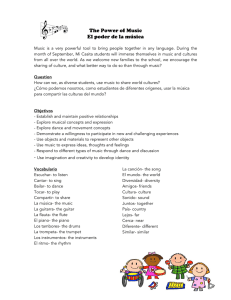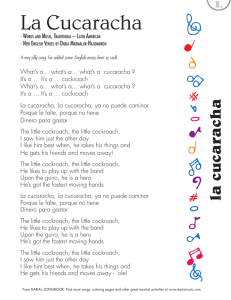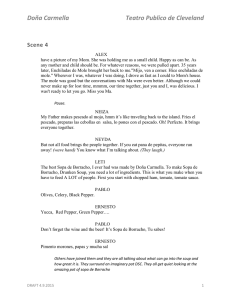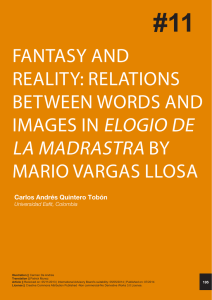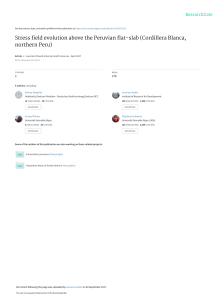Music and Dance
Anuncio
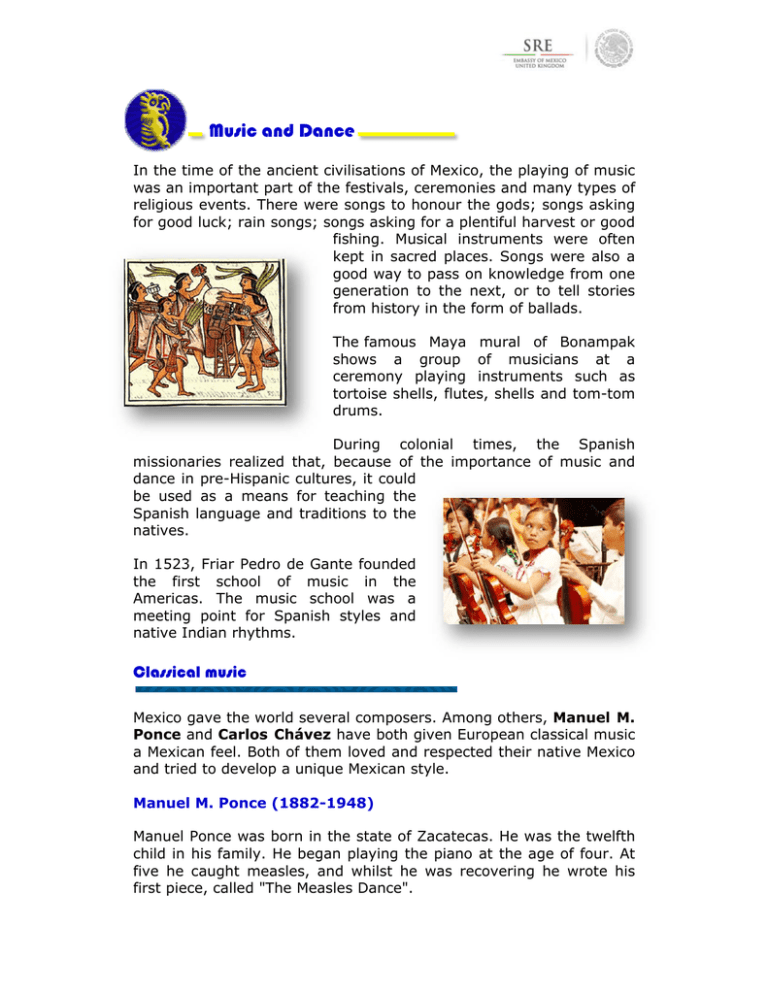
Music and Dance In the time of the ancient civilisations of Mexico, the playing of music was an important part of the festivals, ceremonies and many types of religious events. There were songs to honour the gods; songs asking for good luck; rain songs; songs asking for a plentiful harvest or good fishing. Musical instruments were often kept in sacred places. Songs were also a good way to pass on knowledge from one generation to the next, or to tell stories from history in the form of ballads. The famous Maya mural of Bonampak shows a group of musicians at a ceremony playing instruments such as tortoise shells, flutes, shells and tom-tom drums. During colonial times, the Spanish missionaries realized that, because of the importance of music and dance in pre-Hispanic cultures, it could be used as a means for teaching the Spanish language and traditions to the natives. In 1523, Friar Pedro de Gante founded the first school of music in the Americas. The music school was a meeting point for Spanish styles and native Indian rhythms. Classical music Mexico gave the world several composers. Among others, Manuel M. Ponce and Carlos Chávez have both given European classical music a Mexican feel. Both of them loved and respected their native Mexico and tried to develop a unique Mexican style. Manuel M. Ponce (1882-1948) Manuel Ponce was born in the state of Zacatecas. He was the twelfth child in his family. He began playing the piano at the age of four. At five he caught measles, and whilst he was recovering he wrote his first piece, called "The Measles Dance". At 19, he sold his piano to go to Europe, where he studied music in Italy and Germany. He composed hundreds of pieces for piano and guitar. Some of these pieces made him famous in Europe. It has been said that the music of Ponce is "the finest ever written for the classical guitar". Many famous guitarists have played Ponce's music, including the great Andrés Segovia and John Williams. Carlos Chavez (1899-1978) Carlos Chávez was born in Mexico City, the seventh child in his family. He liked to listen to both classical European and Mexican Indian music, and studied the instruments used by the Maya and Aztecs. He used pre-hispanic music and instruments in his works, such as his Indian Symphony. He was a pupil of Manuel Ponce and started Mexico's Symphonic Orchestra. He was also popular in France, Belgium and Italy. National Symphony Orchestra of Mexico National Symphony Orchestra of Mexico Composers in Mexico today are following the tradition of musicians such as Silvestre Revueltas and Pablo Moncayo. Young female composers like Marcela Rodríguez are also contributing to Mexican classical music. Popular music The mariachi typifies Mexican popular music. The first mariachi bands appeared in the state of Jalisco in the eighteenth century. Mariachi bands are made up of eight players or more, with guitars, violins, trumpets, and a singer. They play on special holidays or parties. Mariachis and smaller bands called Trios (a group of three people) also play "serenades", a very romantic type of song. Bands are regularly hired by men to accompany them as they sing serenades outside the house of their girlfriends, on birthdays, to end a quarrel, or for other special reasons. The girlfriend turns on her bedroom light to show she is listening. The corrido is a type of song which tells a story, perhaps about a person or something that happened. They were first sung at the time of the Mexican Revolution early in the 20th century. They were often made up on the spur of the moment and were a way of telling news at a time when there was no radio or television. A popular melody was often used again and again by simply adding new verses. Many corridos were written about heroes of the Revolution like Pancho Villa, Emiliano Zapata or Venustiano Carranza. People in towns and villages were eager to hear new corridos that described the most recent events. Two popular songs for you to sing 1. Cielito Lindo (Lovely Heaven) De la Sierra Morena, Cielito lindo vienen bajando. Un par de ojitos negros, Cielito lindo de contrabando. Ay, ay, ay, ay. Canta y no llores porqué cantando se alegran, Cielito lindo los corazones. This is a love song that a young girlfriend. He calls her his "cielito lindo". man sings to his She has beautiful black eyes and she comes down the Sierra Morena mountain to see him. The chorus of the song says: "sing, don't cry, because singing makes your heart happy”. 2. La Cucaracha (The Cockroach) Ya murió la cucaracha, ya la llevan a enterrar, entre cuatro zopilotes, y un ratón de sacristán. The poor cockroach is dead, and is going to be buried, between four vultures, and a sexton mouse. La cucaracha, la cucaracha, ya no puede caminar, porque le falta, porque no tiene, las dos patitas de atrás. The cockroach, the cockroach, can't walk anymore, because she needs, because she's missing her two back legs to walk. Popular Dances La Danza del Venado (The Dance of the Deer) This is a native Mexican dance from the state of Sonora. During the dance one of the dancers is wrapped in skins and wears a head-dress of antlers. Rattles are tied around his wrists and ankles so with every step he takes, he makes a sound. The dancer crouches and jumps, imitating the movements of a deer. El Jarabe Tapatio (The Hat Dance) The jarabe comes from Jalisco and is danced by a single couple. The man dances around the girl, pretending to court her. The girl first rejects his advances, but finally accepts them. At the end of the dance the man throws his sombrero (hat) at the feet of the girl. She welcomes this challenge by stepping onto the brim of his hat and dancing the final steps around its broad edge. The Dance of the Little Old Men This is a dance from the State of Michoacán and it is usually performed by very agile young men who pretend to be wrinkled old men, bent over with age. Playground or Party Game Here is a Mexican game for you to play with your friends: Doña Blanca (Mrs. White) Directions: Holding hands the children form a circle pretending to be the pillars. Someone is chosen to be "Doña Blanca" and stands in the centre of the circle. Someone else is chosen to be the "jicotillo" (the hornet) and stands outside the circle. Then everybody starts singing: Verse 1 (all) "Doña Blanca está cubierta con pilares de oro y plata. Romperemos un pilar para ver a Doña Blanca." As the children sing the first verse they swing their hands back-and-forth in time to the music. Doña Blanca runs inside the circle form by her pillars. The "hornet" skips round the outside of the circle, following Doña Blanca. Verse 2 (Doña Blanca and the hornet) Doña Blanca: "Quien es ese jicotillo que anda en pos de Doña Blanca?" Hornet: "Yo soy ese jicotillo que anda en pos de Doña Blanca" The second verse is sung by Doña Blanca and the hornet. The hornet asks if he can break one of the pillars and get inside the circle to get Doña Blanca. The hornet asks the pillars: What are you made of? The pillars reply that they are silver or gold, or something soft like paper or straw. If the pillars are soft, the children drop their hands and the hornet chases Doña Blanca in and out of the circle. When she is caught, Doña Blanca closes her eyes and chooses a child to become the next Doña Blanca. The hornet also chooses someone to become the new hornet. When you are asked "What are you made of?" you can use the following names of some materials in Spanish: oro - gold plata - silver papel - paper cristal - crystal tela - cloth
